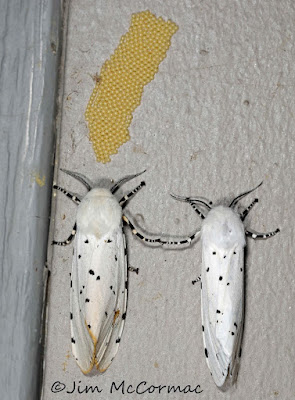A Salt Marsh Moth, Estigmene acrea, peeks around a corner at the camera. Were it the size of a swan, we'd be terrified. As it is, most of us probably think it's cute.
Despite the geographically inappropriate name, this species is common throughout Ohio, including urban haunts such as where I dwell. I made the image above back in 2012, in the shadow of downtown Columbus's skyscrapers. They also appear from time to time at my nightlights.
After returning from some late night errand on the evening of July 27, I noticed a female Salt Marsh Moth had fluttered into the sphere of my porch light. When I left for work early the next morning, it was still present, firmly ensconced in a sheltered spot near the front door.
When I returned home that evening (July 28), big things had happened. The female moth had dumped eggs galore. I estimate (too lazy to count them all, but have at it if it tickles your fancy) about 400 of the tiny beadlike eggs. She very carefully squirts the miniscule eggs out like some sort of lepidopteran assembly line worker, depositing them in neat, tightly packed rows. The eggs are somewhat viscous, and adhere firmly to the substrate.
A glance around revealed a male had joined her, apparently during the day while I was gone. He, of course, is a necessity for reproduction. Moths can be exceptionally good at locating members of the opposite sex via pheromones. Highly sensitive receptors in their antennae allow the males to unerringly navigate to females, even if they are considerable distances away.
I was curious to observe the hatching of the caterpillars, and figured it would only be three or four days before they popped forth. Sure enough, when I arrived home on the evening of August 1, the eggs had noticeably darkened, and it looked like the hatching was eminent. When I checked on them around 9:30 that evening, caterpillars were busting loose.
Brand new first instar caterpillars wriggle loose from their eggs. At this point, they are incredibly small, perhaps a millimeter or so in length. Most people, if they noticed them at all, would probably not recognize the little larvae for what they are. They'll grow like weeds, at least those that successfully run the predatorial gauntlet. One of these caterpillar will molt five times, each time emerging larger than before. Each stage between molts is termed an instar. When it reaches the last instar, it'll be hundreds of times more massive than at this point.
As the night wore on, the eruption of caterpillars grew more intense. When I made this image - probably around 11 pm - a great many had already chewed their way free. Nearly all of the rest were well on their way. In this photo, you can see caterpillars largely free of the shell, eggs whose occupants have already escaped, and lots of eggs with the cats actively chewing their way out.
Making acceptable images of this Lilliputian scene was no easy feat, in large part because the moth had placed the eggs in a tough to access spot. I couldn't use a tripod to stabilize my rig for ultra-crisp exposures. For the last image, I used Canon's remarkable MP-E 65mm mega-macro lens. It can produce stunning images of the tiniest subjects, but demands dead still stabilization which was hard to achieve in this situation. Nonetheless, watching the cats emerging through the microscope-like view offered by this lens was cool. I could see them moving inside the opaque eggs, then suddenly a tiny hole would appear. The caterpillar would rapidly chew its way out at that point, taking only a few minutes or so to free itself once it first opened a hole.
The little caterpillars will face many perils, and most won't survive the predatory gauntlet. They've got to reach suitable food plants - many acceptable host plants are nearby - and eat and grow while avoid being eaten themselves. In spite of their best efforts, there will be near complete mortality. David Wagner, caterpillar expert and author of Caterpillars of Eastern North America, estimates that for many moth species larval mortality is about 99%. This is why many moths produce so many eggs. It's necessary in order to ensure that a few of them make it all the way to adulthood. Those that don't make it serve a vital purpose, too - they are part of Nature's complex food chain, and fuel a great many other animal species.






1 comment:
Fascinating, and yes a beautiful moth.
I had a stink bug lay eggs on the patio doors last year. It as fun to watch them hatch too. Miracles.
Post a Comment